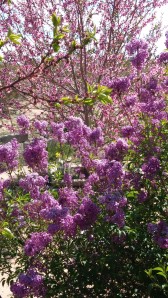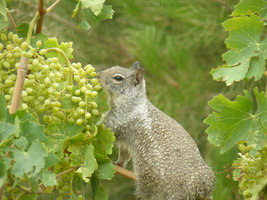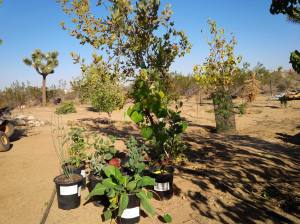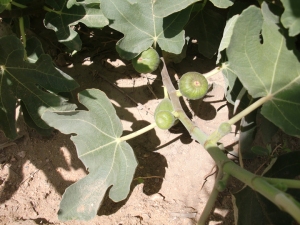I realized recently that I’m finally thinking like a desert gardener/farmer.
Maybe I should say thinking more like one.
You can’t grow any kind of garden out here without altering your thinking about gardens somewhat and rapidly.
I began to look to the land on my first high desert farm. I responded to what I observed. Still, I used so many conventional practices back in the day, chief among them “just apply water.”
Of course we have to find ways to get water to cultivated plants in arid and semi-arid landscapes. And we want to use it carefully, conservatively. That goes without saying.
Also, I did learn the value of microclimates on the old farm: olive trees were able to thrive and bear fruit in a warm and sheltered enclosure between my kitchen and garage. Places where water pooled (but didn’t stagnate) were helpful for some plants. Shady places helped other plants.
That was only the beginning.
Rainshadow Farm has required me to sit with the land more than I ever have before. I’ve learned from the land more than I ever thought possible. And I’ve done a few things more unconventionally than I had ever expected when I began this arid lands journey over 25 years ago.
Last week I saw this video of someone growing figs in a pretty unconventional way.
This technique is sometimes called ground layering. I do it with the lilacs I grow because I need to have lilac plants around my house, even if I don’t live in Ohio any more. A farmer friend told me I should try it with the grapevines that grow along my fence line.
When I watched the video, I thought about our figs. I planted four young fig trees. One did not last through a high desert winter, three did.
Of the three that remained, there was some die-back. Two of the trees lost some branches. In fact they lost the “central leader” branch. By late spring and early summer of the following year, I realized I had one tree beyond recovery and three young fig trees that winter had pruned into fig bushes. If I wanted to sound more professional, I could say my figs are pruned into an extremely modified central leader pattern.
But that’s not entirely true unless I were to add “Nature did it.”
I suppose if you live in the low desert, you’ll have other problems with your figs, but winter die-back is not likely to be a problem.
Figs prefer well-drained soil where it is sunny, hot, and arid. They don’t mind sandy, rocky soil. They like a lot of sun.
Ours are on a slight rise with coarse sandy soil. They are located where they get plenty of high desert sun. The fig that died completely in the high desert winter was exposed to a week or so of sub-zero temperatures. Mulching it heavily at the base did not help it to survive. The other figs were tougher and did survive.
Here’s how we handle the winter now.
People say figs don’t like it below 10 degrees F. We get at least a week of that and even colder temperatures each winter.
Here’s What I do: I place a poultry wire cage (the kind I use to deter ground squirrels) around the young tree and fill it up with straw. That’s all. After I started doing that, my remaining fig trees managed to survive.
If I wanted to offer more protection, which I will very likely do when I plant more young figs, I will prune (if needed), then wrap the tree with burlap. I’ll leave the top of the burlap open , so that excess moisture and heat doesn’t affect the tree. After that, I’ll install the poultry wire cage and fill it with straw mulch.
Finally, if I want some serious extra protection, I’ll wrap a cylinder of bubble wrap or some heavy duty gardening plastic around the cage. In extremely cold weather I might cover the top for the most extreme cold, but that may not be necessary.
I used a bubble wrap bubble to protect a yerba mansa ( Anemopsis californica) plant that I installed near the patio since a friend told me that it might die at temperatures below 20 degrees F.
The yerba mansa is in the very front here and right now it looks pretty much the same. Well, bigger. It’s in the ground. It’s spreading. Spring growth is happening. It’s in a moist micro-zone.
Why yerba mansa? I found some growing once along the Mojave River when I did an archaeological survey and it fascinated me. Just look at it!
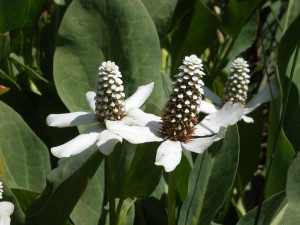
Yerba Mansa by Calibas (http://commons.wikimedia.org/wiki/User:Calibas)
Daniel Moerman (1998, see below) says that Native Americans across California and the Desert Southwest had an abundance of uses for yerba mansa, mostly medicinal but also as food. It’s a pretty powerful medicine from the looks of the ethnobotanical list. I don’t know if I’ll use it, but it’s very cool to have it growing here.
Back to the figs.
The young trees not only need some winter protection, they need some extra water in the heat of the desert. Wilted leaves are a good indicator they are thirsty. At the end of summer if they dry out a bit it seems to be okay. People say this makes the fruit sweeter. We like them; the birds like them for sure.
Check this out:

